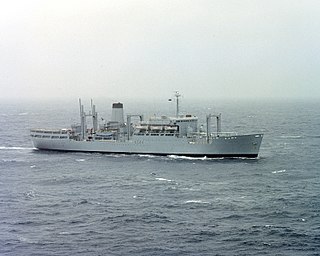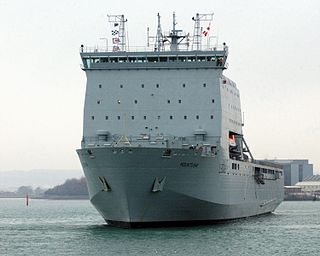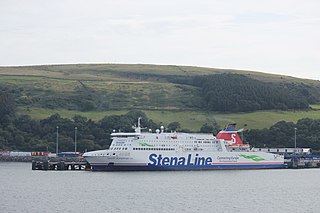
The Royal Fleet Auxiliary (RFA) is a naval auxiliary fleet owned by the UK's Ministry of Defence. It is a component of His Majesty's Naval Service and provides logistical and operational support to the Royal Navy and Royal Marines. The RFA ensures the Royal Navy is supplied and supported by providing fuel and stores through replenishment at sea, transporting Royal Marines and British Army personnel, providing medical care and transporting equipment and essentials around the world. In addition the RFA acts independently providing humanitarian aid, counter piracy and counter narcotic patrols together with assisting the Royal Navy in preventing conflict and securing international trade. They are a uniformed civilian branch of the Royal Navy staffed by British merchant sailors. The RFA is one of five RN fighting arms.

Stena Line is a Swedish shipping line company and one of the largest ferry operators in the world. It services Denmark, France, Germany, the United Kingdom, Ireland, Latvia, the Netherlands, Norway, Poland, Finland and Sweden. Stena Line is a major unit of Stena AB, itself a part of the Stena Sphere.

HMS Illustrious was a light aircraft carrier of the Royal Navy and the second of three Invincible-class ships constructed in the late 1970s and early 1980s. She was the fifth warship and second aircraft carrier to bear the name Illustrious, and was affectionately known to her crew as "Lusty". In 1982, the conflict in the Falklands necessitated that Illustrious be completed and rushed south to join her sister ship HMS Invincible and the veteran carrier HMS Hermes. To this end, she was brought forward by three months for completion at Swan Hunter Shipyard, then commissioned on 20 June 1982 at sea en route to Portsmouth Dockyard to take on board extra stores and crew. She arrived in the Falklands to relieve Invincible on 28 August 1982 in a steam past. Returning to the United Kingdom, she was not formally commissioned into the fleet until 20 March 1983. After her South Atlantic deployment, she was deployed on Operation Southern Watch in Iraq, then Operation Deny Flight in Bosnia during the 1990s and Operation Palliser in Sierra Leone in 2000. An extensive re-fit during 2002 prevented her from involvement in the 2003 Iraq War, but she was returned to service in time to assist British citizens trapped by the 2006 Lebanon War.

RFA Diligence was a forward repair ship of the Royal Fleet Auxiliary. Launched in 1981 as a support ship for North Sea oil rigs, she was chartered by the British government to support naval activities during the 1982 Falklands War and was later bought outright as a fleet maintenance vessel. She gave assistance to the damaged USS Tripoli and Princeton in the 1991 Gulf War, and to Sri Lanka after the 2005 tsunami. She typically had deployments of 5-8 years in support of the Trafalgar-class submarine on duty east of Suez, with a secondary role as a mothership for British and US minesweepers in the Persian Gulf. Until 2016 Diligence was set to go out of service in 2020. However in August 2016, the UK Ministry of Defence placed an advert for the sale of RFA Diligence. As of 2016 the option for the delivery of future operational maintenance and repair capability for the RFA remained under consideration. However, the 2021 British defence white paper made no specific mention of the need for this capability. In April 2023, it was revealed that the ship was to be scrapped after no suitable buyers materialised, & she was moved out of 3 Basin across to Fareham Trots to await her final journey to the scrapyard.
RFA Sea Crusader was a fast sealift ship chartered to Britain's Royal Fleet Auxiliary between 1996 and 2003 and subsequently in commercial service with Cobelfret on North Sea routes as MV Celestine. She was described by the RFA as a "Strategic Lift Ro-Ro".

RFA Stromness (A344) was a fleet stores ship which served the Royal Fleet Auxiliary until sold to the U.S. Navy's Military Sealift Command in 1983. While in the service of British forces, it saw service in the Falklands War. After the sale to the United States, it was renamed USNS Saturn (T-AFS-10) and acted as a combat stores ship until it was deactivated in 2009; it was able to supply two other ships at once. In 2010, it was sunk in an exercise by the U.S. Carrier Strike Group Two off the coast of North Carolina.

RFA Lyme Bay is a Bay-class auxiliary dock landing ship of the British Royal Fleet Auxiliary (RFA). Ordered from Swan Hunter in 2000, the ship was launched in 2005. However, cost overruns and delays saw the shipbuilder removed from the project, and the incomplete ship was towed to Govan for finishing by BAE Systems Naval Ships. Lyme Bay entered service in late 2007; the last ship of the class to join the RFA.

The Bay class is a ship class of four dock landing ships built for the British Royal Fleet Auxiliary (RFA) during the 2000s. They are based on the Dutch-Spanish Royal Schelde Enforcer design, and replaced the Round Table-class logistics ships. Two ships each were ordered from Swan Hunter and BAE Systems Naval Ships. Construction work started in 2002, but saw major delays and cost overruns, particularly at Swan Hunter's shipyard. In mid-2006, Swan Hunter was stripped of work, and the incomplete second ship was towed to BAE's shipyard for completion. All four ships, Largs Bay, Lyme Bay, Mounts Bay, and Cardigan Bay had entered service by 2007.

Finnlines Plc is a shipping operator of ro-ro and passenger services in the Baltic Sea and the North Sea. It is a subsidiary of the Grimaldi Group. Finnlines’ sea transports are concentrated in the Baltic and the North Sea. Finnlines’ passenger-freight vessels offer services from Finland to Germany and via Åland to Sweden as well as from Sweden to Germany. The Company has subsidiaries in Germany, Belgium, Great Britain, Sweden, Denmark and Poland. In addition to sea transportation, the Company provides port services in Finland in Helsinki and Turku.

MS Stena Superfast VIII is a fast Ro-Pax ferry owned and operated by Stena Line between Belfast and Cairnryan. The ship was built in 2001 by Howaldtswerke-Deutsche Werft (HDW), Kiel, Germany for Attica Group's subsidiary Superfast Ferries. She was sold to her current owners in 2017.

The Point class is a class of six roll-on/roll-off sealift ships originally procured under a Private Finance Initiative to be available for use as naval auxiliaries to the British armed forces. Two of the ships have now been released from the contract, leaving four available for service with the military.

MS UR is a roll-on/roll-off freight ferry built in 2009 owned by Arab Bridge Maritime. She was owned by Clipper Group and has been chartered to a number of operators.

MS Baltic Ferry was built in 1978 by South Korean-based Hyundai H.I. for Stena Lines who had intended her, and 10 sister ships to be used for charter or sale to other operators. She was chartered by Townsend Thoresen in 1980, staying with them and their successor P&O Ferries and P&O Irish Sea until 2005. In 1982 the Ministry of Defence requisitioned the vessel to transport troops to the Falkland Islands.

Stena Germanica is a large cruiseferry operated by Stena Line between Gothenburg and Kiel, together with MS Stena Scandinavica (2002). Between 2001 and 2010, as Stena Hollandica she operated on the Harwich to Hook of Holland service.

MS Blue Carrier 1 is a ro-ro ferry built in 2000 for Norfolkline BV and now operates in the Aegean Sea for Blue Star Ferries.
The Type C7 ship(Lancer Class) is a United States Maritime Administration (MARAD) designation for a cargo ship and the first US purpose-built container ship. The vessels were constructed in US shipyards and entered service starting in 1968. As US-built ships they were Jones Act qualified for shipments between US domestic ports. Under the Jones Act, domestic US maritime trade is restricted to US-built and flagged vessels of US owners and manned by predominantly US-citizen crews. The last active Lancer container-configured ship was scrapped in 2019. Lancers of the vehicle Roll-on/Roll-off (RO/RO) configuration remain held in the Ready Reserve Force, National Defense Reserve Fleet and the US Navy Military Sealift Command. All are steam powered.

Stena Livia is a roll-on/roll-off (Ro/Ro) ferry operated by Stena Line on their Travemünde–Liepaja service. It was built in 2008, and originally named Norman Voyager.
Jacklyn, formerly known as LPV, Stena Freighter, Stena Seafreighter, RFA Sea Chieftain, and Stena Hispanica, was a roll-on/roll-off cargo ship which was purchased by Blue Origin in 2018 for use as a landing platform ship. Ultimately, Blue Origin abandoned their plans to use the ship as a landing platform, and in August 2022, the ship was towed to the Port of Brownsville for scrapping.















